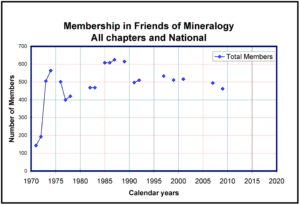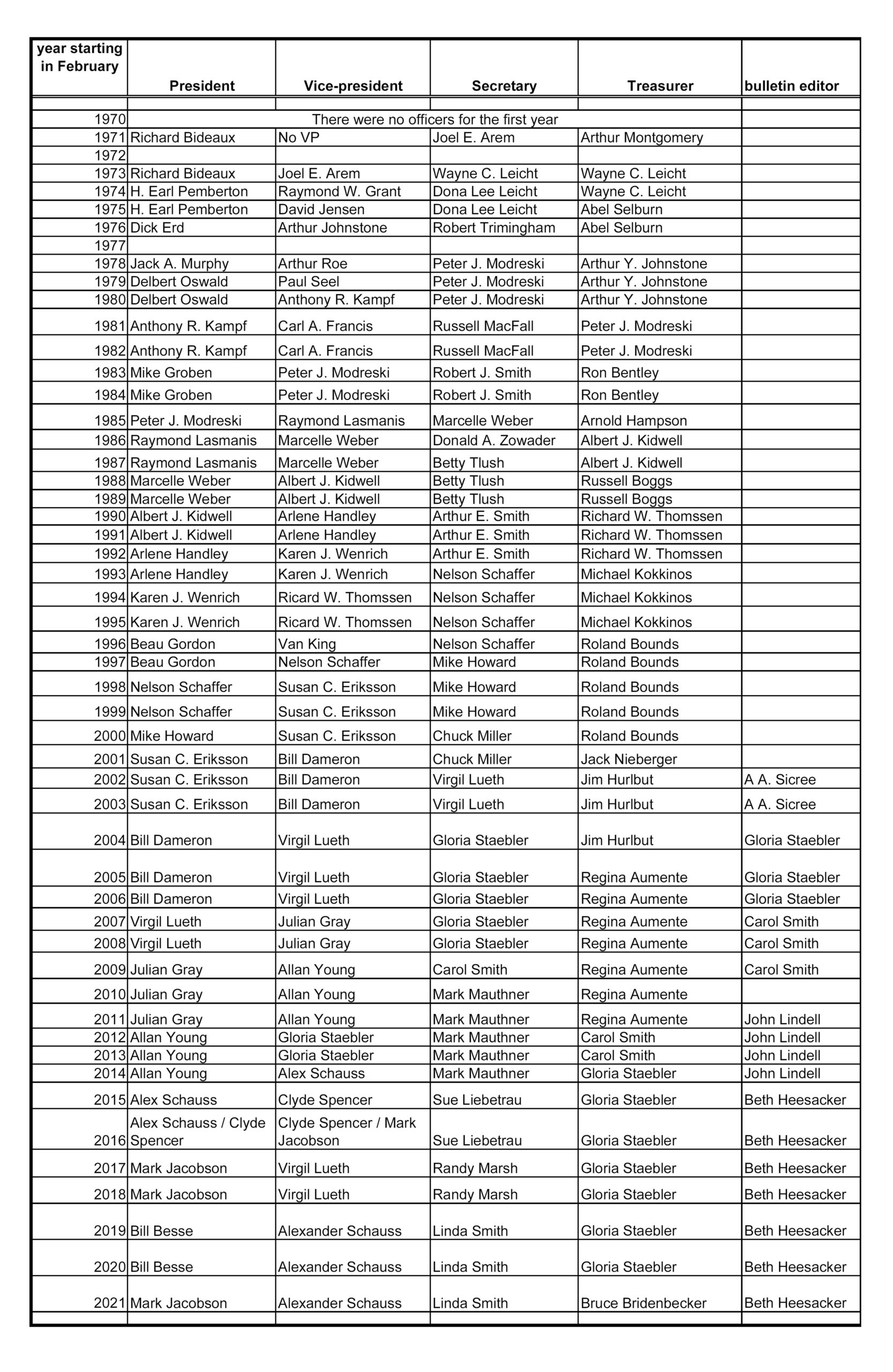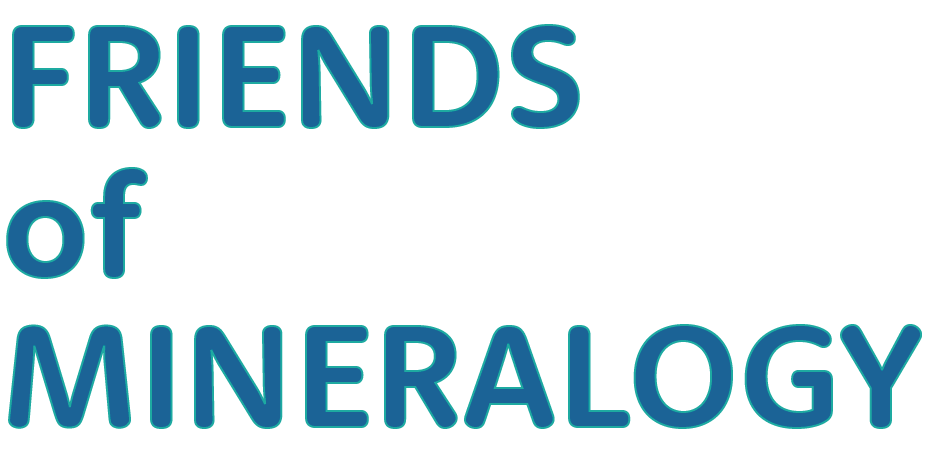The creation of FM
On 13 February 1970, twenty prominent specimen mineralogy advocates met at the home of George A. Bideaux in Tucson and proposed a national organization of not more than 100 people to advocate for specimen and locality mineralogy. These twenty were John Anthony (1920-1992), Richard A. Bideaux (1935-2004), George Bideaux (1897-1978), Paul Desautels (1920-1991), Peter G. Embry (1929–2010), Joseph J. Finney (1927-), Joaquin Folch Girona (1892-1984), Richard Gaines (1917-1999), Mike Groben (1928-2015), Jack Hanahan (1924-2001), Russell M. Honea (1929-2002), Mike Kokinos (1927- ), Arthur Montgomery (1909-1999), Louis Moyd (1916-2006), Fred Pough (1906-2006), Julian R. Reasenberg (1916-1985), John Sinkankas (1915-2002), John White, Jr. (1933- ), Sidney A. Williams (1933-2006), and Leo Neal Yedlin (1908-1977).
Joel Arem (1943- ), Richard Bideaux, Raymond W. Grant (1937- ), Mike Groben and Arthur Montgomery proposed in a memo that the aims and activities of this Friends of Mineralogy group on March 9, 1970 should include:
“1. Compiling and publicizing information on important mineral collections throughout the world.
- Encouraging improved educational use and far wiser conservation of mineral specimens, collections, and localities.
- Supporting a semi-professional journal of high excellence and interest designed to appeal to mineral amateurs and professionals alike, also to undergraduates active in earth science, and through which FM activities may be circulated.
- Operating informally and altruistically on behalf of minerals, mineral collecting, and descriptive mineralogy, with dependence on voluntary support primarily by members and widest possible circulation of the journal.
- Functioning by means of fullest membership participation and majority decision, with responsibility for implementation of aims and activities channeled through an annually-selected regional committee willing to do the brunt of the work.
- Cooperating as fully as possible with IMA and all mineral societies, professional and amateur, and guarding against overlap of functions performed by these groups.
- Building an active world-wide membership among amateur and professional mineralogists.”
As a group, they saw a gap of knowledge, interaction and activities between the professional mineralogists, geologists, geochemists, and museum curators, and the amateur mineral clubs composed of families with young curious children and retired people wanting new activities and social networks. The organization as conceived by Arthur Montgomery and Dick Bideaux was supposed to be populated 50-50% by professionals and amateurs, where the professionals are curators, university professors, and researchers and the amateurs consisting of mineral dealers and enthusiastic mineral collectors. The idea of keeping the membership to less than a 100 disappeared the first year, when essentially all the leading mineral enthusiasts of all educational backgrounds wanted in. One of the new society’s goals was to minimize the perceived professional/amateur, degree/non-degree divide in the mineral community.
This new group wanted to do more than bridge the education gap but literally fill this gap with knowledgeable, self-educating people who were thrilled with minerals for their beauty, properties, where they came from, how they were formed, and how we got them out of the earth. This was a pre-internet, pre-cell phone age. For amateurs, talking face to face, faceting and polishing rocks, making jewelry, reading magazines and books, listening to 35 mm slide presentations, buying mineral specimens, exhibiting at shows, winning exhibit trophies, and digging in the field for specimens were the activities of choice. The scientific community meanwhile had moved away from specimen mineralogy, their professional activities entailed determining the structures of minerals, predicting the properties of materials based on structure and elements, developing methods to find more economic mineral deposits, and how to extract the valuable elements.
The American Mineralogist was moving away from descriptive mineralogy and mineral localities to material science. The Lapidary Journal, once the literary home for amateur mineral clubs and some serious mineralogical writers, started to change its identity during the 1970s to purely gems and jewelry. The remaining hobby magazines – leaders like Gems and Minerals, Earth Science and Rocks & Minerals had changed little during the 1960s. The 1970’s brought changes to the mineral magazines; some were improvements and some were not. As ownership changed, and editors retired, attracting unpaid, high quality mineral articles became more difficult. The rise of the Mineralogical Record caused some writers to migrate away from their previous journals. Mineral Club bulletins also started publishing better articles, increasing the competition for the few writers. Mineral locality guidebooks proliferated during the 1960s, increasing people pressure on collecting. Access to collecting localities where there are no public lands, as on the East Coast and Midwest continued to decrease for several reasons, frustrating families and collectors alike. Western USA collecting on government lands became more intensive but did not arouse too much push-back from public land managers until the 1980s.
Friends of Mineralogy chose to colonize this social-ecological gap and fill it with enthusiastic mineral dealers, avocational (unpaid) scientists, curators, researchers and amateur collectors who wanted to do more than collect a few pretty rocks or facet some large exotic stones. FM’s mission thus became to promote, support, protect, and expand the collecting of mineral specimens, while furthering the recognition of the scientific, historical, economic, and aesthetic value of minerals, mineral collecting and mineral collectors.
Historical membership

Historical officers

